Tate & Lyle Bundle
Who Really Owns Tate & Lyle?
Understanding the ownership structure of a global powerhouse like Tate & Lyle is crucial for anyone looking to navigate the complexities of the food and beverage industry. The company's strategic direction, financial performance, and market impact are all deeply intertwined with its shareholder base. A significant shift occurred in November 2024 with the acquisition of CP Kelco, reshaping the company's focus and ownership landscape.
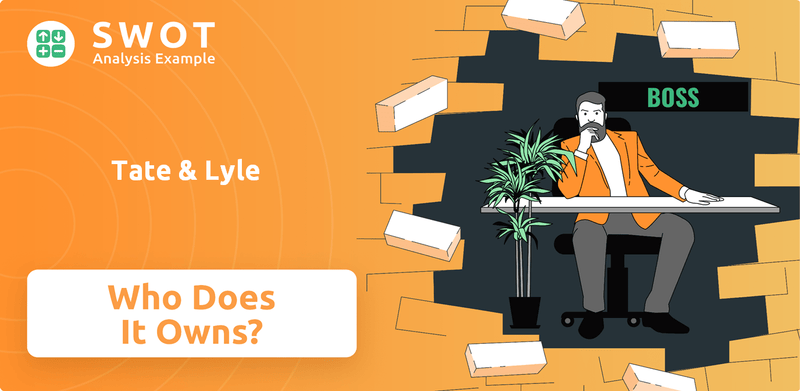
Tate & Lyle, a British-headquartered company with a rich Tate & Lyle SWOT Analysis, has a fascinating ownership journey, from its roots in the sugar industry to its current status as a public company. Knowing who owns Tate & Lyle provides critical insights into its strategic decisions and future prospects. This article will explore the evolution of Tate & Lyle ownership, examining key shareholders and the impact of recent acquisitions on the company's governance and strategic direction. The company, now a part of the FTSE 250 Index, operates globally, and its financial performance is a key indicator of its success.
Who Founded Tate & Lyle?
The origins of the current company, trace back to two distinct sugar refining businesses: Henry Tate & Sons and Abram Lyle & Sons. These two entities, despite being rivals, would eventually merge, shaping the landscape of the sugar industry in the United Kingdom. The formation of the company involved significant restructuring, consolidating control and vision under a new combined entity.
Henry Tate started his sugar business in 1859 in Liverpool. Abram Lyle, a cooper and shipowner, entered the sugar refining industry in 1865. The merger of these two companies in 1921 marked a pivotal moment, creating a dominant force in the UK sugar market.
The merger of Henry Tate & Sons and Abram Lyle & Sons in 1921 to form the company, was a strategic move. This consolidation aimed to create a strong entity capable of competing in the evolving sugar market. The company's initial structure was family-run before transitioning to a public entity.
Henry Tate and Abram Lyle are the founders of the companies that merged to form the company.
Initially, the company was family-run. It later became a public entity.
The merger took place in 1921.
At the time of the merger, the combined entity refined approximately 50% of the UK's sugar.
The merger aimed to create a stronger entity capable of competing in the sugar market.
The founding families' descendants, like John O. Lyle and Saxon Tate, played a role in the company's diversification efforts in the 1970s.
The ownership of the company has evolved significantly since its inception. The company's history from family-run to a publicly traded entity reflects broader trends in the business world. If you want to learn more about the company's history, you can read this article about the company's history.
- Initially family-owned.
- Transitioned to a publicly traded firm.
- Founding families retained influence through descendants.
- The merger was a strategic move to strengthen market position.
Tate & Lyle SWOT Analysis
- Complete SWOT Breakdown
- Fully Customizable
- Editable in Excel & Word
- Professional Formatting
- Investor-Ready Format
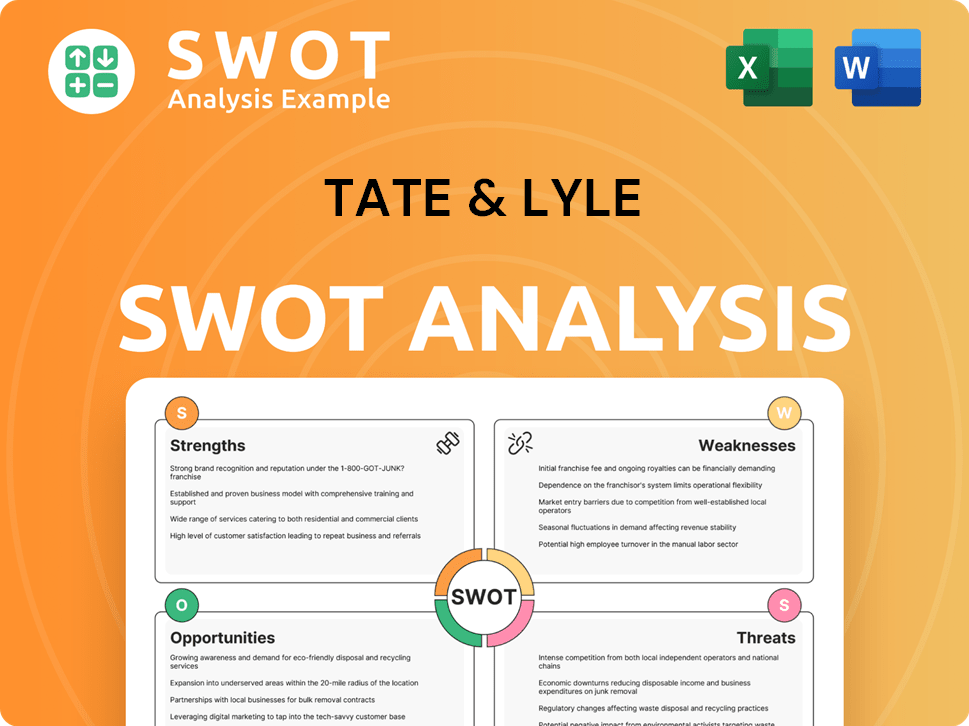
How Has Tate & Lyle’s Ownership Changed Over Time?
The ownership structure of Tate & Lyle has evolved significantly since its formation in 1903 as Henry Tate & Sons (1903) Limited, later merging to become Tate & Lyle, Limited in 1921. The company's strategic direction shifted notably in the 1970s with diversification efforts, followed by a major divestiture in 2010 when it sold its sugar business, including the Lyle's Golden Syrup brand, to American Sugar Refining, Inc. (ASR). This move marked a decisive pivot away from refined sugar production, focusing instead on food ingredients.
A critical turning point occurred in April 2022 when Tate & Lyle sold a controlling stake in its Primary Products business in North and Latin America to KPS Capital Partners LP, resulting in a new entity called Primient. Initially, KPS Capital Partners held a 50.1% interest, while Tate & Lyle retained a 49.9% interest. The strategic transformation concluded in June 2024, with Tate & Lyle completing the sale of its remaining 49.7% interest in Primient to KPS Capital Partners for US$350 million (£277 million).
| Key Event | Date | Impact on Ownership |
|---|---|---|
| Formation of Henry Tate & Sons | 1903 | Initial corporate structure |
| Merger to form Tate & Lyle Limited | 1921 | Consolidation and expansion |
| Divestiture of Sugar Business | 2010 | Strategic shift to food ingredients |
| Sale of Primary Products Stake to KPS Capital Partners | April 2022 | Creation of Primient, with Tate & Lyle retaining a minority stake |
| Sale of Remaining Primient Stake to KPS Capital Partners | June 2024 | Complete divestiture of Primary Products business |
| J.M. Huber Corporation becomes largest shareholder | November 2024 | Huber holds approximately 15.7% of issued share capital |
In November 2024, J.M. Huber Corporation emerged as the largest shareholder of Tate & Lyle, holding approximately 15.7% (or 16%) of its issued share capital. This followed Tate & Lyle's acquisition of CP Kelco from Huber, a deal valued at around $1.8 billion (£1.4 billion), settled through the issuance of 75 million new Tate & Lyle ordinary shares to Huber and a cash payment. This acquisition and the resulting change in ownership structure, as highlighted in this Growth Strategy of Tate & Lyle article, has significantly influenced Tate & Lyle's governance, with Huber now entitled to appoint two non-executive directors to the Tate & Lyle Board. The company's focus has subsequently shifted towards specialty food and beverage solutions.
Tate & Lyle has undergone significant ownership changes.
- The company divested its sugar business in 2010.
- KPS Capital Partners acquired a controlling stake in the Primary Products business.
- J.M. Huber Corporation is now the largest shareholder.
- The strategic focus is on specialty food and beverage solutions.
Tate & Lyle PESTLE Analysis
- Covers All 6 PESTLE Categories
- No Research Needed – Save Hours of Work
- Built by Experts, Trusted by Consultants
- Instant Download, Ready to Use
- 100% Editable, Fully Customizable
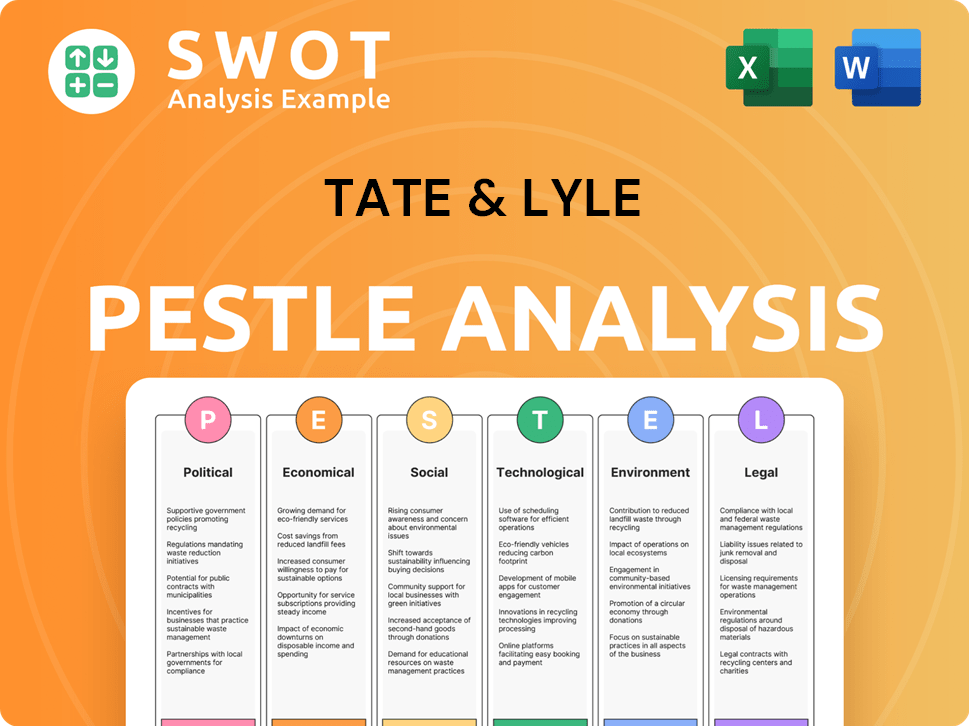
Who Sits on Tate & Lyle’s Board?
The Board of Directors is the primary decision-making body for Tate & Lyle, responsible for the Group's financial and operational performance. As of March 2024, the board includes a mix of executive and independent non-executive directors. David Hearn serves as the Chair of the Board, appointed from January 1, 2024, and also chairs the Nominations Committee. Nick Hampton is the Chief Executive, and Sarah Kuijlaars is the Chief Financial Officer, having joined the Board in September 2024.
The board also includes Independent Non-Executive Directors such as Jeff Carr (who also chairs the Remuneration Committee as of January 1, 2025), John Cheung, Dr. Isabelle Esser, Lars Frederiksen, Kimberly Nelson (Senior Independent Director), and Warren Tucker (Chair of the Audit Committee). Following the acquisition of CP Kelco in November 2024, J.M. Huber Corporation, a significant shareholder (approximately 15.7% of issued share capital), has appointed two non-executive directors to the Tate & Lyle Board: Glenn M. Fish and Cláudia Vaz de Lestapis. The board is committed to diversity, aiming for at least 40% women, 40% men, and two directors of minority ethnic representation.
| Director | Role | Appointment Date |
|---|---|---|
| David Hearn | Chair of the Board | January 1, 2024 |
| Nick Hampton | Chief Executive | N/A |
| Sarah Kuijlaars | Chief Financial Officer | September 2024 |
| Jeff Carr | Independent Non-Executive Director | N/A |
| John Cheung | Independent Non-Executive Director | N/A |
| Dr. Isabelle Esser | Independent Non-Executive Director | N/A |
| Lars Frederiksen | Independent Non-Executive Director | N/A |
| Kimberly Nelson | Senior Independent Director | N/A |
| Warren Tucker | Independent Non-Executive Director | N/A |
| Glenn M. Fish | Non-Executive Director | Following CP Kelco Acquisition (November 2024) |
| Cláudia Vaz de Lestapis | Non-Executive Director | Following CP Kelco Acquisition (November 2024) |
Tate & Lyle operates on a one-share-one-vote structure for its ordinary shares, as indicated by the share consolidation in 2022. There are no special voting rights or founder shares that would grant outsized control to specific entities beyond their shareholding percentage. Recent changes in board composition reflect the evolving ownership landscape, particularly after the acquisition of CP Kelco in November 2024.
The Board of Directors is responsible for the financial and operational performance of Tate & Lyle. The company operates on a one-share-one-vote structure.
- David Hearn is the Chair of the Board.
- J.M. Huber Corporation holds approximately 15.7% of issued share capital.
- The board aims for diversity in its composition.
- The acquisition of CP Kelco in November 2024 led to changes in the board.
Tate & Lyle Business Model Canvas
- Complete 9-Block Business Model Canvas
- Effortlessly Communicate Your Business Strategy
- Investor-Ready BMC Format
- 100% Editable and Customizable
- Clear and Structured Layout
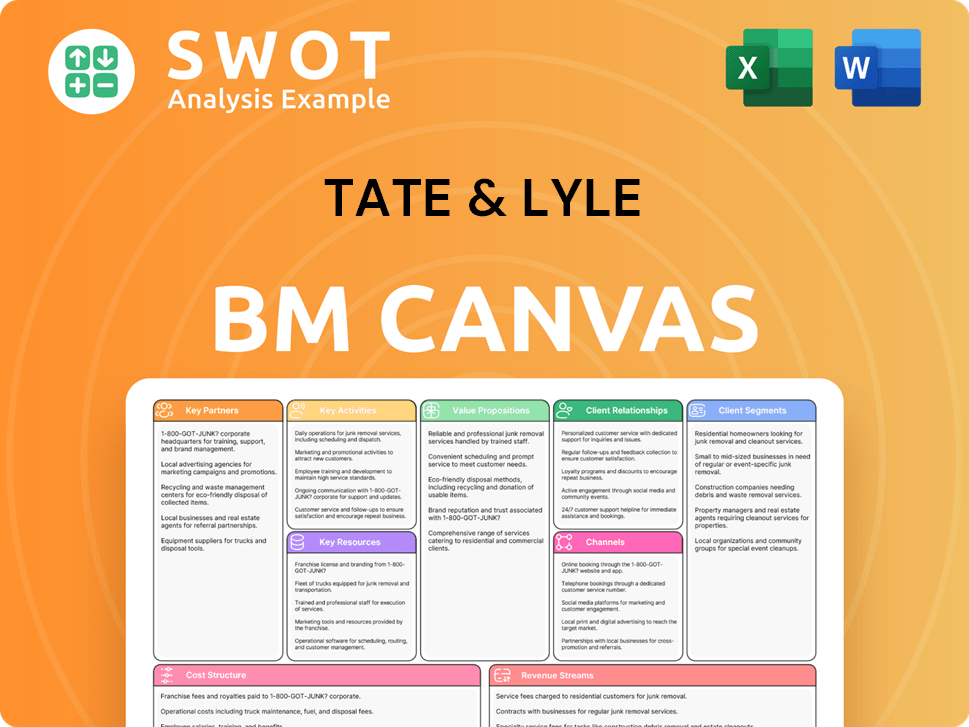
What Recent Changes Have Shaped Tate & Lyle’s Ownership Landscape?
Over the past few years, the ownership structure of Tate & Lyle has undergone significant changes. A major shift involved the divestment of its Primary Products business. In April 2022, the company sold a controlling stake (50.1%) in this division, creating Primient in partnership with KPS Capital Partners LP. This strategic move was finalized in June 2024, when Tate & Lyle sold its remaining 49.7% interest in Primient to KPS Capital Partners for US$350 million (£277 million), fully exiting the commodity ingredients sector.
Simultaneously, Tate & Lyle has focused on expanding its specialty food and beverage solutions business. A key acquisition was CP Kelco, a provider of pectin and specialty gums, purchased from J.M. Huber Corporation for approximately $1.8 billion (£1.4 billion). This acquisition, completed on November 15, 2024, made J.M. Huber Corporation a significant shareholder in Tate & Lyle, holding about 15.7% of the issued share capital and appointing two non-executive directors to the board. These actions reflect a broader industry trend toward consolidation and a focus on higher-value, specialty ingredients. For a deeper understanding of their market approach, consider exploring the Marketing Strategy of Tate & Lyle.
These strategic changes aim to accelerate growth and improve adjusted EBITDA margin. Furthermore, the company has been actively repurchasing its shares. In the fiscal year ending March 31, 2025, Tate & Lyle purchased 31,294,579 ordinary shares at a total cost of £216 million. Leadership changes have also occurred, with David Hearn assuming the role of Chair of the Board from January 1, 2024. These developments indicate a clear strategic direction for Tate & Lyle as a global leader in specialty food and beverage solutions.
The acquisition of CP Kelco from J.M. Huber Corporation for approximately $1.8 billion significantly expanded Tate & Lyle's specialty ingredients portfolio.
Tate & Lyle repurchased 31,294,579 ordinary shares for £216 million in the fiscal year ended March 31, 2025, reflecting confidence in its future.
The company is concentrating on specialty food and beverage solutions, aiming for higher-value products and increased profitability.
The sale of the remaining stake in Primient to KPS Capital Partners marks a complete exit from commodity ingredients.
Tate & Lyle Porter's Five Forces Analysis
- Covers All 5 Competitive Forces in Detail
- Structured for Consultants, Students, and Founders
- 100% Editable in Microsoft Word & Excel
- Instant Digital Download – Use Immediately
- Compatible with Mac & PC – Fully Unlocked
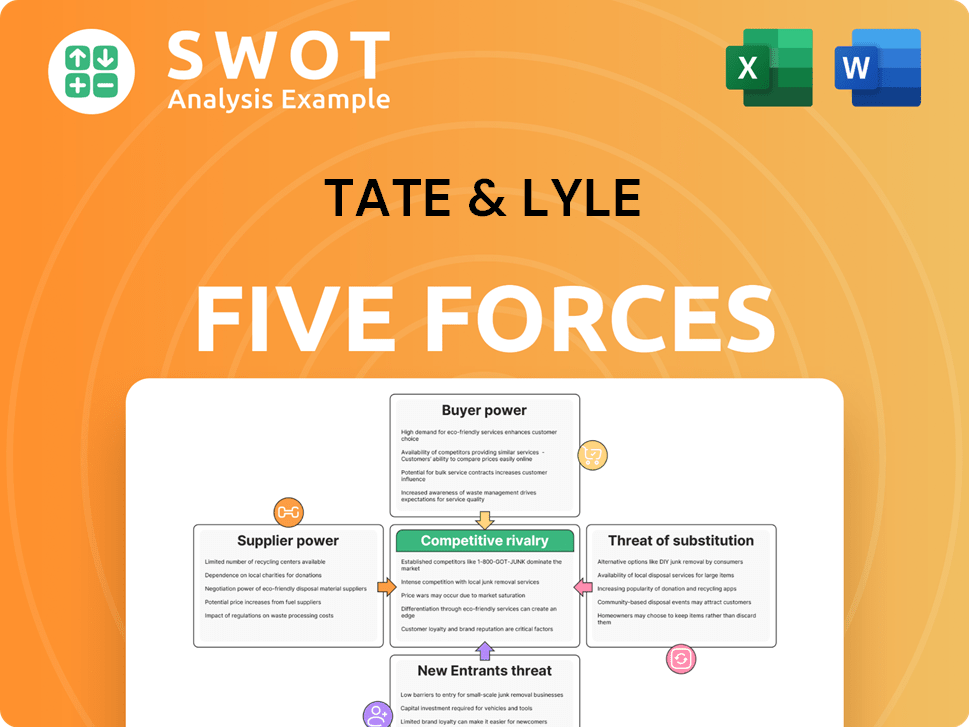
Related Blogs
- What are Mission Vision & Core Values of Tate & Lyle Company?
- What is Competitive Landscape of Tate & Lyle Company?
- What is Growth Strategy and Future Prospects of Tate & Lyle Company?
- How Does Tate & Lyle Company Work?
- What is Sales and Marketing Strategy of Tate & Lyle Company?
- What is Brief History of Tate & Lyle Company?
- What is Customer Demographics and Target Market of Tate & Lyle Company?
Disclaimer
All information, articles, and product details provided on this website are for general informational and educational purposes only. We do not claim any ownership over, nor do we intend to infringe upon, any trademarks, copyrights, logos, brand names, or other intellectual property mentioned or depicted on this site. Such intellectual property remains the property of its respective owners, and any references here are made solely for identification or informational purposes, without implying any affiliation, endorsement, or partnership.
We make no representations or warranties, express or implied, regarding the accuracy, completeness, or suitability of any content or products presented. Nothing on this website should be construed as legal, tax, investment, financial, medical, or other professional advice. In addition, no part of this site—including articles or product references—constitutes a solicitation, recommendation, endorsement, advertisement, or offer to buy or sell any securities, franchises, or other financial instruments, particularly in jurisdictions where such activity would be unlawful.
All content is of a general nature and may not address the specific circumstances of any individual or entity. It is not a substitute for professional advice or services. Any actions you take based on the information provided here are strictly at your own risk. You accept full responsibility for any decisions or outcomes arising from your use of this website and agree to release us from any liability in connection with your use of, or reliance upon, the content or products found herein.